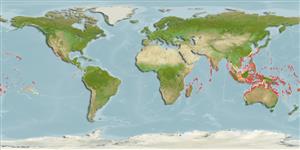Common names from other countries
>
Tetraodontiformes (Puffers and filefishes) >
Tetraodontidae (Puffers) > Canthigasterinae
Etymology: Canthigaster: Greek, kanthos = the outer or inner corner of the eye, where the lids meet, 1646 + Greek, gaster = stomach (Ref. 45335).
More on author: Bleeker.
Environment: milieu / climate zone / depth range / distribution range
Écologie
marin récifal; profondeur 1 - 30 m (Ref. 1602). Tropical; 32°N - 32°S
Indo-Pacific: East Africa south to Transkei, South Africa (Ref. 4919) and east to the Line, Marquesan, and Oeno islands, north to southern Japan, south to Lord Howe Island. Replaced by Canthigaster jactator in the Hawaiian Islands and Canthigaster punctatissimus in the tropical eastern Pacific (Ref. 37816). Also recorded from Southeast Atlantic.
Taille / Poids / Âge
Maturity: Lm ? range ? - ? cm
Max length : 9.0 cm TL mâle / non sexé; (Ref. 4919)
Description synthétique
Clés d'identification | Morphologie | Morphométrie
Épines dorsales (Total) : 0; Rayons mous dorsaux (Total) : 9 - 10; Épines anales: 0; Rayons mous anaux: 9 - 10. Many white spots scattered on body (Ref. 559).
Occurs in clear lagoon and seaward reefs, Ref. 48637. Found with sponges at various depths (Ref. 48637). Prefers sheltered areas in the form of holes in dead and living corals. Solitary or paired. Feeds on sponges, polychaetes, filamentous algae and on smaller quantities of tunicates, crustaceans, echinoderms and corals.
Life cycle and mating behavior
Maturities | Reproduction | Spawnings | Egg(s) | Fecundities | Larves
Myers, R.F., 1991. Micronesian reef fishes. Second Ed. Coral Graphics, Barrigada, Guam. 298 p. (Ref. 1602)
Statut dans la liste rouge de l'IUCN (Ref. 130435)
CITES (Ref. 128078)
Not Evaluated
Menace pour l'homme
Harmless
Utilisations par l'homme
Pêcheries: commercial; Aquarium: Commercial
Outils
Articles particuliers
Télécharger en XML
Sources Internet
Estimates based on models
Preferred temperature (Ref.
115969): 24.7 - 29.3, mean 28.3 (based on 2816 cells).
Phylogenetic diversity index (Ref.
82804): PD
50 = 0.5000 [Uniqueness, from 0.5 = low to 2.0 = high].
Bayesian length-weight: a=0.03631 (0.01554 - 0.08482), b=2.88 (2.69 - 3.07), in cm Total Length, based on LWR estimates for this Genus-body shape (Ref.
93245).
Niveau trophique (Ref.
69278): 3.1 ±0.32 se; based on food items.
Résilience (Ref.
120179): Haut, temps minimum de doublement de population inférieur à 15 mois (Preliminary K or Fecundity.).
Fishing Vulnerability (Ref.
59153): Low vulnerability (10 of 100).
